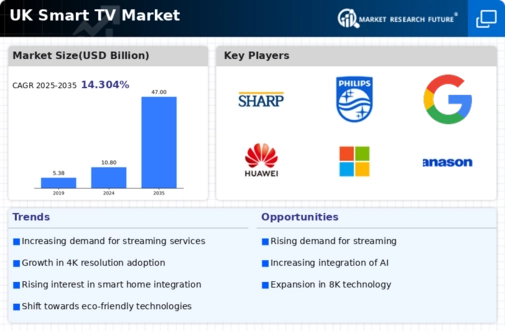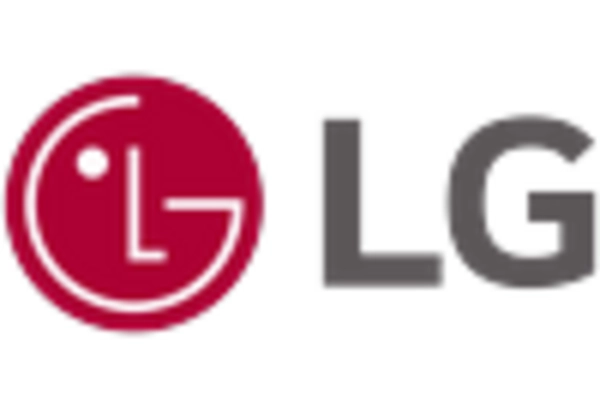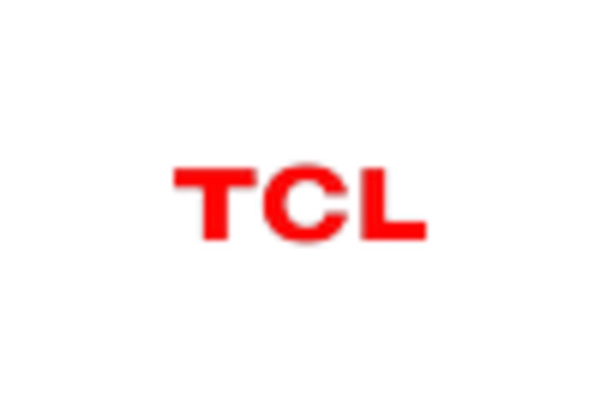Growing Popularity of Interactive Content
The market is increasingly influenced by the growing popularity of interactive content, such as gaming and virtual reality experiences. As consumers seek more engaging entertainment options, smart tvs are evolving to accommodate these preferences. In the UK, the gaming industry has seen substantial growth, with revenues reaching £7 billion in 2025, which correlates with the rising demand for smart tvs that support high-performance gaming. This trend is encouraging manufacturers to develop smart tvs with enhanced processing power and low latency features, catering to gamers' needs. As a result, the smart tv market is likely to expand as consumers invest in devices that offer immersive and interactive experiences.
Rising Awareness of Smart Home Integration
The market is experiencing growth driven by rising awareness of smart home integration. As consumers become more familiar with smart home technologies, they are increasingly seeking devices that can seamlessly connect and interact with their home ecosystems. In the UK, the market for smart home devices is projected to reach £10 billion by 2026, highlighting the potential for smart tvs to serve as central hubs for controlling various smart devices. This trend encourages manufacturers to develop smart tvs with enhanced compatibility features, allowing users to manage lighting, security, and other home systems directly from their televisions. Consequently, the smart tv market is likely to expand as consumers look for multifunctional devices that enhance their overall smart home experience.
Technological Advancements in Display Quality
The market is experiencing a notable shift due to advancements in display technologies such as OLED and QLED. These innovations enhance picture quality, offering deeper blacks and more vibrant colors, which appeal to consumers seeking superior viewing experiences. In the UK, the demand for high-definition content is rising, with 4K and 8K resolutions becoming increasingly popular. As a result, manufacturers are investing heavily in research and development to improve display technologies. This trend is likely to drive sales in the smart tv market, as consumers are willing to pay a premium for enhanced visual experiences. Furthermore, the integration of artificial intelligence in display technology is expected to personalize viewing experiences, further stimulating market growth.
Shift Towards Subscription-Based Content Models
The market is being shaped by a significant shift towards subscription-based content models. With the proliferation of streaming services, consumers are increasingly opting for on-demand content rather than traditional cable subscriptions. In the UK, over 50% of households subscribe to at least one streaming service, indicating a strong preference for flexible viewing options. This trend is prompting smart tv manufacturers to enhance their devices' compatibility with various streaming platforms, ensuring seamless access to a wide array of content. As consumers continue to prioritize convenience and choice, the smart tv market is likely to benefit from this transition, as more individuals invest in smart tvs that facilitate easy access to their preferred content.
Increased Consumer Demand for Connectivity Features
The market is witnessing a surge in consumer demand for enhanced connectivity features. As households become more digitally connected, consumers expect their televisions to seamlessly integrate with various devices, including smartphones, tablets, and gaming consoles. In the UK, approximately 70% of households own at least one smart device, which indicates a strong inclination towards interconnected ecosystems. This trend is prompting manufacturers to incorporate advanced connectivity options such as Wi-Fi 6 and Bluetooth 5.0 in their smart tv offerings. Consequently, the ability to connect multiple devices and access a wide range of applications is likely to drive growth in the smart tv market, as consumers prioritize convenience and versatility in their entertainment systems.
















Leave a Comment